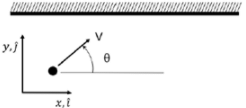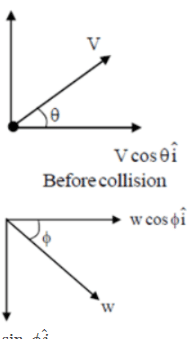GATE Exam > GATE Questions > A point mass having mass M is moving with a ...
Start Learning for Free
A point mass having mass M is moving with a velocity V at an angle θ to the wall as shown in the figure. The mass undergoes a perfectly elastic collision with the smooth wall and rebounds. The total change (final minus initial) in the momentum of the mass is

- a)-2MVcosϕ j^
- b)2MV sin ϕ j^
- c)2MV cos ϕ j^
- d)-2MV sin ϕ j^
Correct answer is option 'D'. Can you explain this answer?
| FREE This question is part of | Download PDF Attempt this Test |
Verified Answer
A point mass having mass M is moving with a velocity V at an angle θ ...
Let w is the velocity after collision
V sinθ j^

−wsin ϕj^
After collision
E = velocity of separation / velocity of approach = 1
{∴ e = 1,or perfectly elastic collision}
= w sin∅j = Vsin∅j _________(1)
Changes in momentum = final momentum - initial momentum
ΔP = {−wsin∅j − (Vsin∅j)}M
= −2MVsin∅j (∵ wsin∅j = Vsin∅j)

|
Explore Courses for GATE exam
|

|
Similar GATE Doubts
A point mass having mass M is moving with a velocity V at an angle θ to the wall as shown in the figure. The mass undergoes a perfectly elastic collision with the smooth wall and rebounds. The total change (final minus initial) in the momentum of the mass isa)-2MVcosϕ j^b)2MV sin ϕ j^c)2MV cos ϕ j^d)-2MV sin ϕ j^Correct answer is option 'D'. Can you explain this answer?
Question Description
A point mass having mass M is moving with a velocity V at an angle θ to the wall as shown in the figure. The mass undergoes a perfectly elastic collision with the smooth wall and rebounds. The total change (final minus initial) in the momentum of the mass isa)-2MVcosϕ j^b)2MV sin ϕ j^c)2MV cos ϕ j^d)-2MV sin ϕ j^Correct answer is option 'D'. Can you explain this answer? for GATE 2024 is part of GATE preparation. The Question and answers have been prepared according to the GATE exam syllabus. Information about A point mass having mass M is moving with a velocity V at an angle θ to the wall as shown in the figure. The mass undergoes a perfectly elastic collision with the smooth wall and rebounds. The total change (final minus initial) in the momentum of the mass isa)-2MVcosϕ j^b)2MV sin ϕ j^c)2MV cos ϕ j^d)-2MV sin ϕ j^Correct answer is option 'D'. Can you explain this answer? covers all topics & solutions for GATE 2024 Exam. Find important definitions, questions, meanings, examples, exercises and tests below for A point mass having mass M is moving with a velocity V at an angle θ to the wall as shown in the figure. The mass undergoes a perfectly elastic collision with the smooth wall and rebounds. The total change (final minus initial) in the momentum of the mass isa)-2MVcosϕ j^b)2MV sin ϕ j^c)2MV cos ϕ j^d)-2MV sin ϕ j^Correct answer is option 'D'. Can you explain this answer?.
A point mass having mass M is moving with a velocity V at an angle θ to the wall as shown in the figure. The mass undergoes a perfectly elastic collision with the smooth wall and rebounds. The total change (final minus initial) in the momentum of the mass isa)-2MVcosϕ j^b)2MV sin ϕ j^c)2MV cos ϕ j^d)-2MV sin ϕ j^Correct answer is option 'D'. Can you explain this answer? for GATE 2024 is part of GATE preparation. The Question and answers have been prepared according to the GATE exam syllabus. Information about A point mass having mass M is moving with a velocity V at an angle θ to the wall as shown in the figure. The mass undergoes a perfectly elastic collision with the smooth wall and rebounds. The total change (final minus initial) in the momentum of the mass isa)-2MVcosϕ j^b)2MV sin ϕ j^c)2MV cos ϕ j^d)-2MV sin ϕ j^Correct answer is option 'D'. Can you explain this answer? covers all topics & solutions for GATE 2024 Exam. Find important definitions, questions, meanings, examples, exercises and tests below for A point mass having mass M is moving with a velocity V at an angle θ to the wall as shown in the figure. The mass undergoes a perfectly elastic collision with the smooth wall and rebounds. The total change (final minus initial) in the momentum of the mass isa)-2MVcosϕ j^b)2MV sin ϕ j^c)2MV cos ϕ j^d)-2MV sin ϕ j^Correct answer is option 'D'. Can you explain this answer?.
Solutions for A point mass having mass M is moving with a velocity V at an angle θ to the wall as shown in the figure. The mass undergoes a perfectly elastic collision with the smooth wall and rebounds. The total change (final minus initial) in the momentum of the mass isa)-2MVcosϕ j^b)2MV sin ϕ j^c)2MV cos ϕ j^d)-2MV sin ϕ j^Correct answer is option 'D'. Can you explain this answer? in English & in Hindi are available as part of our courses for GATE.
Download more important topics, notes, lectures and mock test series for GATE Exam by signing up for free.
Here you can find the meaning of A point mass having mass M is moving with a velocity V at an angle θ to the wall as shown in the figure. The mass undergoes a perfectly elastic collision with the smooth wall and rebounds. The total change (final minus initial) in the momentum of the mass isa)-2MVcosϕ j^b)2MV sin ϕ j^c)2MV cos ϕ j^d)-2MV sin ϕ j^Correct answer is option 'D'. Can you explain this answer? defined & explained in the simplest way possible. Besides giving the explanation of
A point mass having mass M is moving with a velocity V at an angle θ to the wall as shown in the figure. The mass undergoes a perfectly elastic collision with the smooth wall and rebounds. The total change (final minus initial) in the momentum of the mass isa)-2MVcosϕ j^b)2MV sin ϕ j^c)2MV cos ϕ j^d)-2MV sin ϕ j^Correct answer is option 'D'. Can you explain this answer?, a detailed solution for A point mass having mass M is moving with a velocity V at an angle θ to the wall as shown in the figure. The mass undergoes a perfectly elastic collision with the smooth wall and rebounds. The total change (final minus initial) in the momentum of the mass isa)-2MVcosϕ j^b)2MV sin ϕ j^c)2MV cos ϕ j^d)-2MV sin ϕ j^Correct answer is option 'D'. Can you explain this answer? has been provided alongside types of A point mass having mass M is moving with a velocity V at an angle θ to the wall as shown in the figure. The mass undergoes a perfectly elastic collision with the smooth wall and rebounds. The total change (final minus initial) in the momentum of the mass isa)-2MVcosϕ j^b)2MV sin ϕ j^c)2MV cos ϕ j^d)-2MV sin ϕ j^Correct answer is option 'D'. Can you explain this answer? theory, EduRev gives you an
ample number of questions to practice A point mass having mass M is moving with a velocity V at an angle θ to the wall as shown in the figure. The mass undergoes a perfectly elastic collision with the smooth wall and rebounds. The total change (final minus initial) in the momentum of the mass isa)-2MVcosϕ j^b)2MV sin ϕ j^c)2MV cos ϕ j^d)-2MV sin ϕ j^Correct answer is option 'D'. Can you explain this answer? tests, examples and also practice GATE tests.

|
Explore Courses for GATE exam
|

|
Suggested Free Tests
Signup for Free!
Signup to see your scores go up within 7 days! Learn & Practice with 1000+ FREE Notes, Videos & Tests.


















